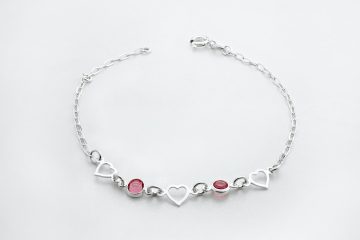Bracelet making is a delightful craft that allows you to create beautiful pieces of jewelry with just a few simple materials. Whether you’re a beginner or an experienced crafter, making bracelets with string can be an enjoyable and rewarding activity. In this step-by-step guide, we’ll take you through the process of creating stunning bracelets using various string techniques. From choosing the right materials to adding unique embellishments, we’ll cover everything you need to know to master the art of bracelet making.
1. Getting Started: Gathering the Materials
Before diving into bracelet making, it’s essential to gather all the necessary materials. Here’s a list of items you’ll need to get started:
Materials:
– String or cord (nylon, cotton, hemp, or embroidery floss)
– Beads, charms, or pendants (optional)
– Scissors
– Ruler or measuring tape
– Tape or clipboard (to secure your bracelet while working)
Once you have all the materials ready, it’s time to choose the right string and beads for your bracelet.
2. Choosing the Perfect String
The choice of string plays a crucial role in bracelet making. Depending on the style and durability you’re aiming for, you can opt for different types of string. Here are some popular choices:
a. Nylon String:
Nylon string is known for its strength and flexibility. It’s perfect for creating durable bracelets that can withstand everyday wear. Nylon string is available in various thicknesses, allowing you to experiment with different designs.
b. Cotton String:
Cotton string is an excellent choice if you prefer a soft and comfortable bracelet. It comes in a wide range of colors and is ideal for creating lightweight and casual designs. Keep in mind that cotton string may not be as durable as nylon, so it’s best suited for occasional wear.
c. Hemp String:
Hemp string is a natural and eco-friendly option for bracelet making. It’s known for its durability and earthy texture. Hemp string is commonly used for creating bohemian and rustic-style bracelets.
d. Embroidery Floss:
Embroidery floss is a versatile string that comes in a vast array of colors. It’s commonly used in friendship bracelets and can create intricate patterns. Embroidery floss is relatively thin, making it ideal for delicate and detailed designs.
3. Adding Beads and Charms
Adding beads or charms to your bracelet can elevate its overall look and make it more personalized. Here’s a step-by-step process to incorporate beads or charms into your design:
a. Selecting the Right Beads or Charms:
Choose beads or charms that complement the style and color scheme of your bracelet. You can opt for glass beads, wooden beads, metal charms, or gemstone beads, depending on the desired aesthetic.
b. Stringing the Beads or Charms:
To incorporate beads or charms into your bracelet, thread them onto the string before you begin the knotting process. You can add them randomly or create a specific pattern by alternating different types of beads.
c. Securing the Beads or Charms:
To prevent the beads or charms from sliding around, tie a small knot on each side of them. This will ensure that they stay in place and maintain the desired spacing.
4. Basic Knotting Techniques
Knotting is the foundation of bracelet making. Mastering a few basic knotting techniques will enable you to create a variety of bracelet designs. Here are two popular knotting techniques to get you started:
a. Square Knot:
The square knot is one of the fundamental knots used in bracelet making. Follow these steps to create a square knot:
1. Take the left string and cross it over the middle string.
2. Pass the right string under the middle string and through the loop created by the left string.
3. Pull both strings to tighten the knot.
4. Repeat the process, starting with the right string this time.
5. Continue alternating between left and right until you reach the desired length.
b. Spiral Knot:
The spiral knot creates a twisted effect in your bracelet. Follow these steps to create a spiral knot:
1. Take the left string and pass it over the middle string.
2. Take the right string and pass it under the left string.
3. Bring the right string over the middle string and through the loop created by the left string.
4. Pull both strings to tighten the knot.
5. Repeat the process, starting with the right string this time.
6. Continue alternating between left and right until you achieve the desired spiral effect.
5. Creating Different Bracelet Patterns
Once you’ve mastered the basic knotting techniques, you can explore various patterns to create unique and eye-catching bracelets. Here are a few popular patterns to try:
a. Chevron Pattern:
The chevron pattern consists of V-shaped designs created using diagonal knots. Follow these steps to create a chevron bracelet:
1. Start with two base strings and secure them.
2. Take the left string and cross it over the middle two strings, forming a backward “4” shape.
3. Pass the right string under the middle two strings and through the loop created by the left string.
4. Pull both strings to tighten the knot.
5. Repeat the process, starting with the right string this time.
6. Continue alternating between left and right until you achieve the desired chevron pattern.
b. Diagonal Pattern:
The diagonal pattern involves creating a series of diagonal knots that form a zigzag design. Here’s how you can create a diagonal bracelet:
1. Start with two base strings and secure them.
2. Take the left string and cross it over the middle string.
3. Pass the right string under the middle string and through the loop created by the left string.
4. Pull both strings to tighten the knot.
5. Repeat the process, starting with the right string this time.
6. Continue alternating between left and right, gradually shifting the starting point of each knot to create a diagonal effect.
6. Adding Closure: Clasps and Knots
Once you’ve completed your bracelet, it’s time to add a closure that will secure it around your wrist. Here are two common methods for adding closures:
a. Clasp Closure:
Using a clasp closure gives your bracelet a professional and polished finish. Here’s how you can add a clasp to your bracelet:
1. Attach a jump ring to one end of your bracelet.
2. Connect the jump ring to one side of the clasp.
3. Repeat the process on the other end of the bracelet, connecting it to the other side of the clasp.
4. Ensure that the jump rings are securely closed to prevent the clasp from detaching.
b. Adjustable Knot Closure:
An adjustable knot closure allows you to easily adjust the size of your bracelet. Here’s how you can create an adjustable knot closure:
1. Leave a long tail of string at the end of your bracelet.
2. Tie a simple overhand knot using the tail.
3. Thread the other end of the bracelet through the knot.
4. Pull both ends of the bracelet to tighten the knot.
5. To adjust the size, slide the knot up or down the bracelet.
7. Experimenting with Color and Texture
Bracelet making offers endless opportunities for experimentation with color and texture. Here are a few ideas to inspire you:
a. Gradient Effect:
Create a beautiful gradient effect by using strings in different shades of the same color. Start with the lightest shade and gradually transition to the darkest shade as you progress.
b. Ombre Effect:
Similar to the gradient effect, the ombre effect involves using strings in different colors that seamlessly blend into one another. Begin with one color and gradually introduce a second color, creating a smooth transition.
c. Mixed Materials:
Incorporate different types of string and materials, such as leather, suede, or metallic threads, to add texture and visual interest to your bracelet.
8. Adding Embellishments and Charms
To make your bracelet truly unique, consider adding embellishments and charms that reflect your personal style. Here are a few ideas:
a. Gemstone Beads:
Add gemstone beads to your bracelet for a touch of elegance and natural beauty. Choose beads in colors that complement your design.
b. Letter Beads:
Personalize your bracelet by adding letter beads that spell out meaningful words or initials. It’s a great way to create customized bracelets for yourself or as gifts.
c. Tassels:
Attach colorful tassels to your bracelet to add a playful and bohemian touch. Experiment with different lengths and colors to achieve the desired effect.
Conclusion
Bracelet making is a creative and enjoyable craft that allows you to express your personal style while creating stunning pieces of jewelry. With the right materials, knotting techniques, and a dash of creativity, you can design beautiful bracelets that reflect your unique taste. Whether you’re a beginner or an experienced crafter, this step-by-step guide has provided you with the knowledge and inspiration to embark on your bracelet making journey.
FAQs
Q1. How long does it take to make a bracelet?
A1. The time required to make a bracelet depends on the complexity of the design and your level of experience. Simple bracelets can be completed in under an hour, while more intricate designs may take several hours or even days.
Q2. Can I use different types of string in one bracelet?
A2. Absolutely! Mixing different types of string can create visually appealing bracelets with contrasting textures. Just make sure the strings are compatible in terms of thickness and durability.
Q3. Are there any safety precautions to keep in mind while making bracelets?
A3. It’s important to handle scissors carefully and keep them out of reach of children. Additionally, if you’re using sharp objects like needles or pins for advanced techniques, be cautious and avoid any accidents.
Q4. Can I sell the bracelets I make?
A4. Yes, you can sell the bracelets you make. Bracelets are a popular item for handmade jewelry enthusiasts, and there are various online platforms and local markets where you can showcase and sell your creations.
Q5. What if I make a mistake while knotting?
A5. Mistakes happen, even to experienced crafters. If you make a mistake while knotting, carefully undo the incorrect knot and redo it correctly. Patience is key, and practice makes perfect!




